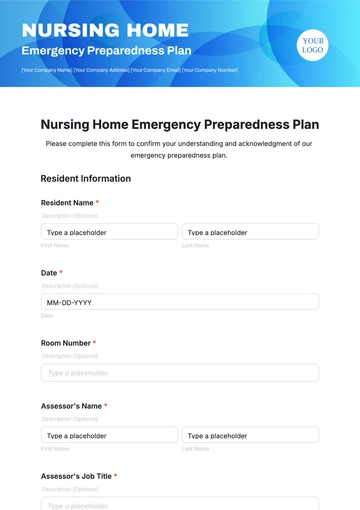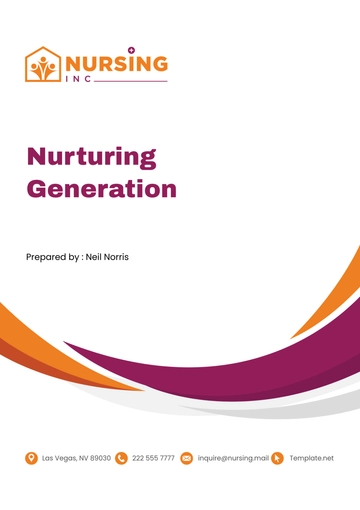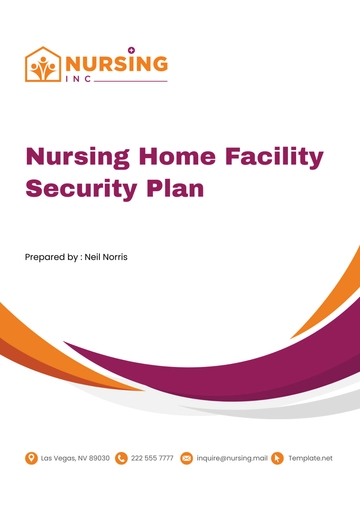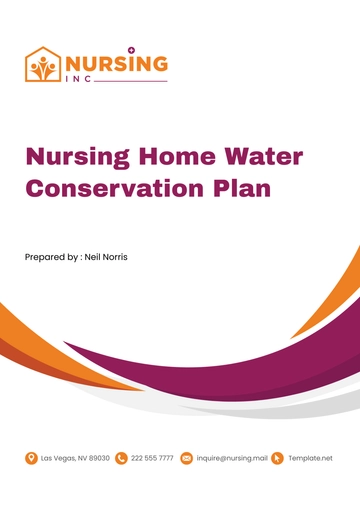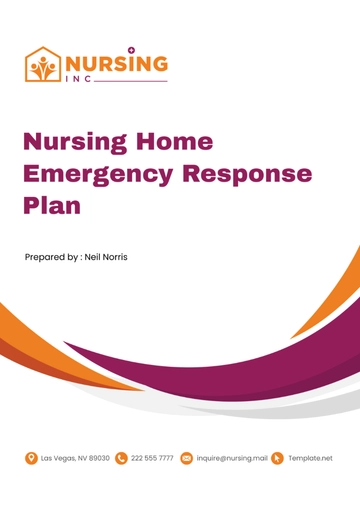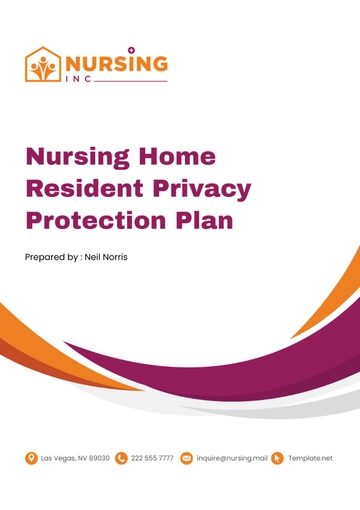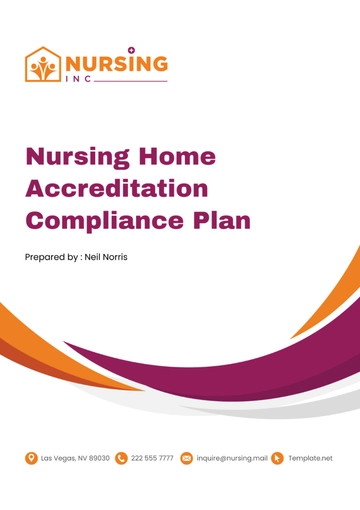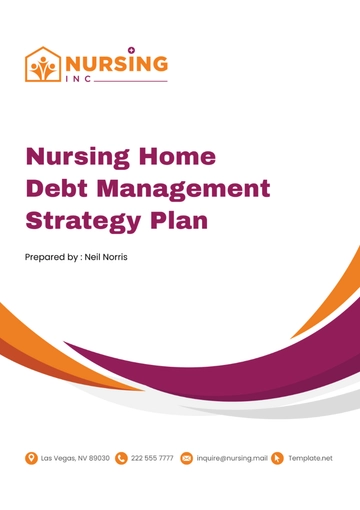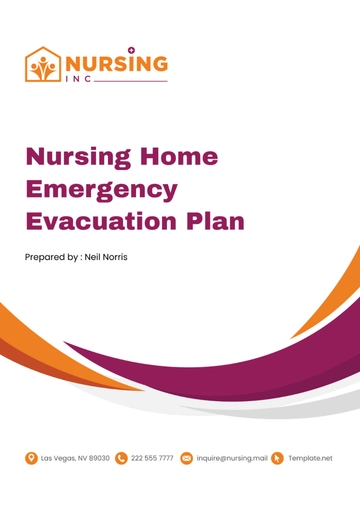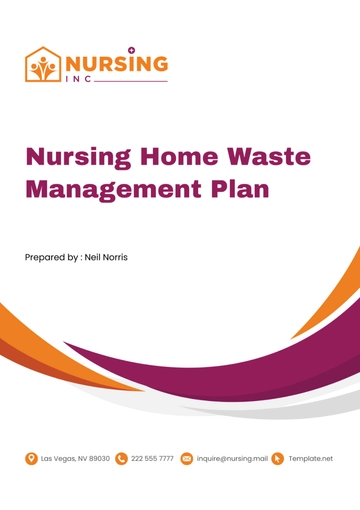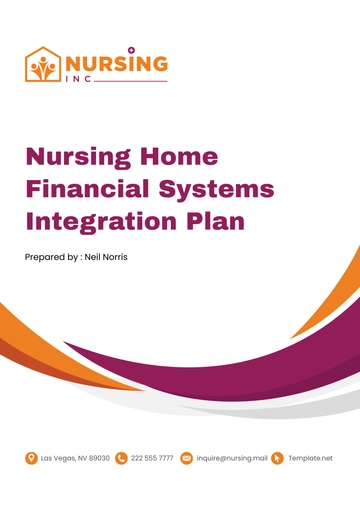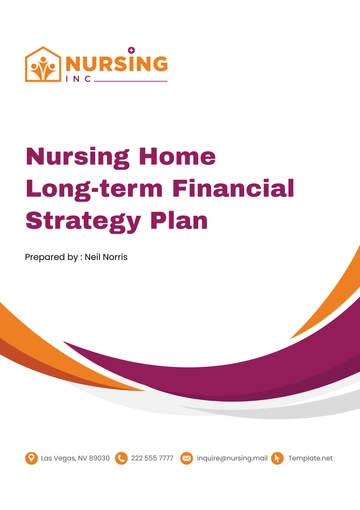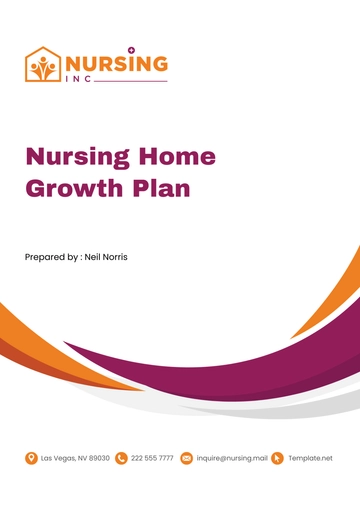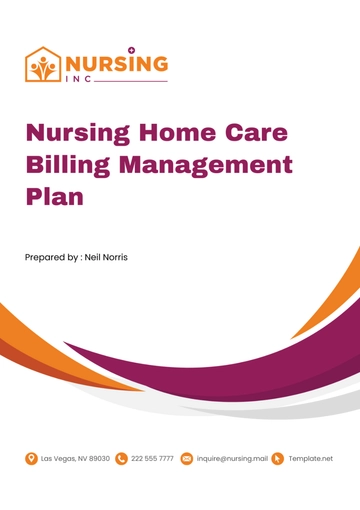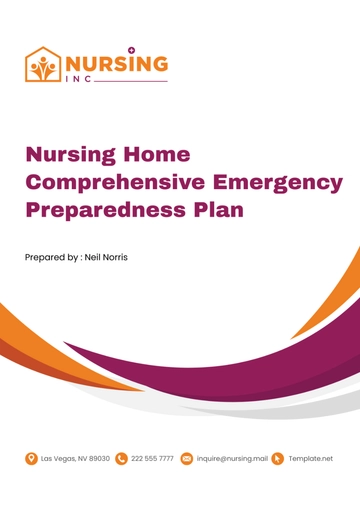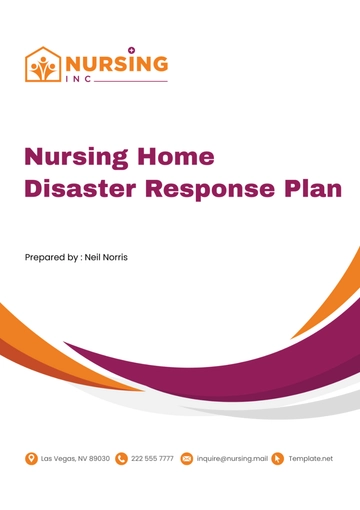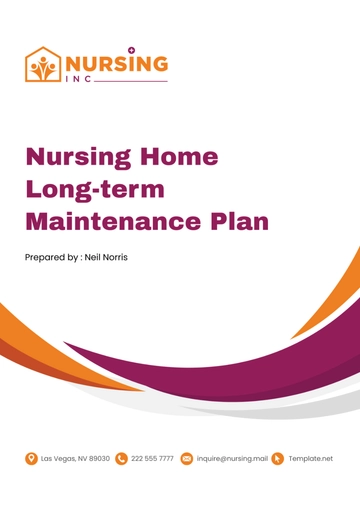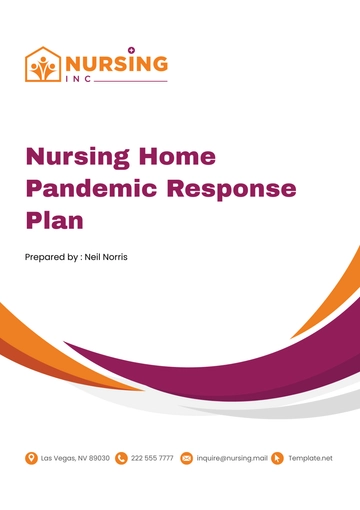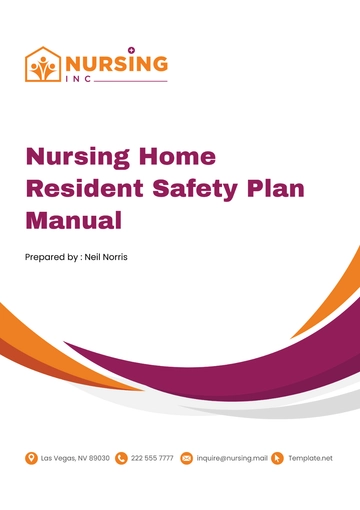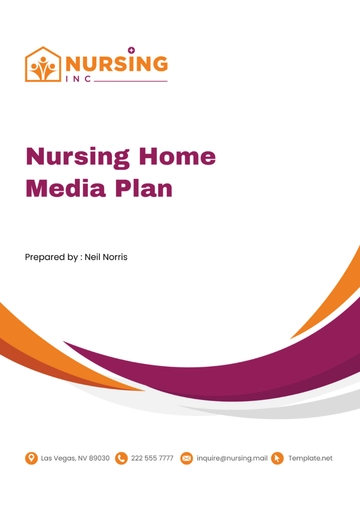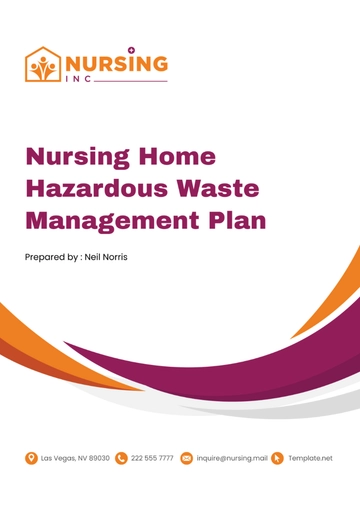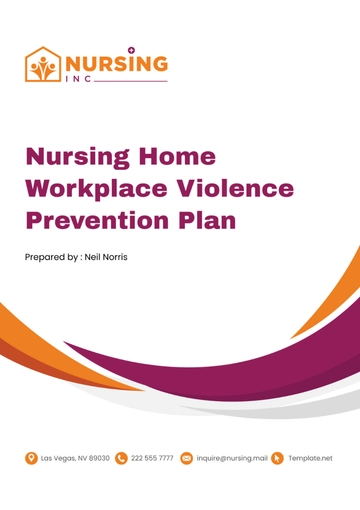Free Nursing Home Emergency Response Plan
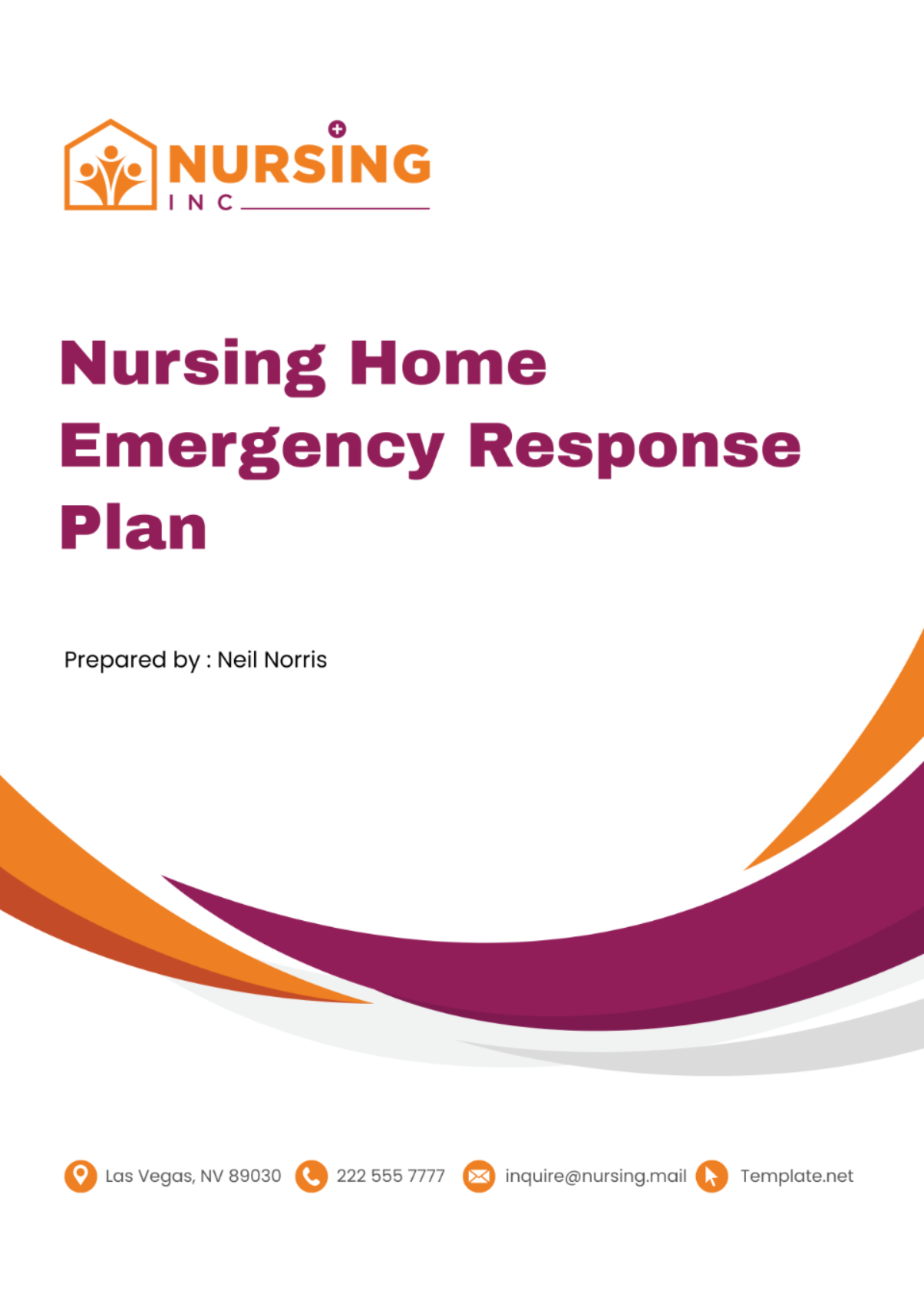
1. Introduction
The Nursing Home Emergency Response Plan developed by [Your Company Name] is dedicated to minimizing potential risks and enhancing the safety measures for our vulnerable seniors. The plan is built on well-established principles and methodologies designed for effective response, preparation, recovery, and mitigation of emergencies that may impact the nursing home environment. At [Your Company Name], we understand that the well-being of our residents is paramount, and our approach integrates state-of-the-art emergency management strategies to protect not only the physical health but also the emotional and psychological well-being of our residents.
For further details or inquiries, please contact:
Email: [Your Company Email]
Phone: [Your Company Number]
Address: [Your Company Address]
2. Purpose and Scope
This comprehensive Emergency Response Plan serves to equip the staff and residents of [Your Company Name]’s nursing homes with the necessary tools and knowledge to respond efficiently to various emergency scenarios. The objective of this plan is to ensure a swift, organized, and effective response to incidents, minimizing their impact on residents and staff alike. The scope of this plan covers a broad spectrum of potential emergencies, including:
Natural Disasters: Such as hurricanes, earthquakes, and floods which pose significant threats due to their unpredictability and potential physical and infrastructural damage.
Human-Initiated Incidents: Including acts of violence, terrorism, and other security breaches that require immediate and strategic responses to ensure the safety and security of all individuals on the premises.
Public Health Crises: Outbreaks of diseases, pandemics, and other health emergencies that demand stringent infection control and medical response strategies to protect the health of our community.
The strategies outlined herein are designed to prepare our team to handle these scenarios with competence and calm, ensuring that the operations can be maintained during crises and that normalcy can be restored as quickly and safely as possible post-incident.
3. Identifying Potential Emergencies
At [Your Company Name], recognizing and understanding the diverse emergencies that can threaten our facilities is a critical component of our preparedness strategy. This section outlines potential emergency scenarios and provides a framework for identifying signs that may precede these events, ensuring readiness and effective response. The emergencies identified include:
Fire: Risks include electrical faults, unattended or mishandled equipment, and general fire hazards common in residential settings. Regular inspections and maintenance are essential to mitigate these risks.
Natural Disasters: Depending on geographic location, our facilities may face hurricanes, earthquakes, or floods. Each type of disaster requires specific preparatory and response measures, such as structural reinforcements for earthquakes or evacuation plans for floods.
Health Emergencies: The close living quarters of nursing homes can lead to rapid disease spread. Vigilant monitoring for symptoms, robust infection control protocols, and coordination with local health authorities are vital.
Power Outages: Critical in nursing homes due to the reliance on power for medical devices and general safety. Backup generators and regular system tests ensure continuous power supply.
Acts of Violence or Terrorism: Though less common, these threats necessitate secure, controlled access to facilities and training for staff in handling aggressive behaviors or active assailant scenarios.
Through regular training, drills, and updates to our emergency plans, staff at [Your Company Name] are empowered to recognize these risks and respond effectively, ensuring the safety and security of all residents and personnel. Each potential emergency has a tailored set of response strategies detailed in later sections of this plan, fostering a secure environment through preparedness and professional response capabilities.
4. Emergency Response Team
The Emergency Response Team at [Your Company Name] is a meticulously selected group of skilled professionals, trained to handle crises efficiently while ensuring the safety and well-being of all residents and staff. The team's structure is designed to cover all critical aspects of emergency management, from logistical support to healthcare needs. Below is an overview of the roles within the team and their specific responsibilities:
Role | Responsibility |
|---|---|
Emergency Manager | Overall coordination of the emergency plan |
Communication Coordinator | Handling external and internal communication during emergencies |
Logistics Coordinator | Arranging resources and materials required during an emergency |
Healthcare Coordinator | Ensuring residents’ medical needs are met |
Transport Coordinator | Planning and executing evacuation plans |
Emergency Manager: Serves as the leader of the response efforts, overseeing the implementation of the emergency plan and coordinating between different response teams. This role involves strategic decision-making, resource allocation, and post-incident review to refine ongoing and future responses.
Communication Coordinator: Manages all communications, ensuring clear, concise, and accurate information dissemination both internally and externally. Responsibilities include alerting staff and residents of emergencies, updating families on the status of their loved ones, and liaising with media and public authorities.
Logistics Coordinator: Responsible for the supply and availability of necessary resources such as emergency kits, medical supplies, and food and water. This role also oversees the maintenance of essential services and infrastructure to ensure they are functional during an emergency.
Healthcare Coordinator: Ensures that all residents receive appropriate medical care and that their health needs are met throughout the emergency. This includes managing the stock of medications, coordinating with medical staff, and overseeing the implementation of infection control protocols.
Transport Coordinator: Develops and executes evacuation plans, including the safe and efficient transport of residents, especially those with special mobility needs. This role coordinates with local transportation services and ensures that vehicles are available and properly equipped.
Each member of the Emergency Response Team is required to undergo regular training and participate in drills to maintain their readiness and ensure that they can perform their duties effectively under pressure.
5. Emergency Action Plan
The Emergency Action Plan of [Your Company Name] is a comprehensive guide designed to prepare staff and residents for a range of emergency situations. It outlines specific actions to be taken to safeguard everyone within the facility during crises:
Alarm Systems: Installation of state-of-the-art alarm systems that detect and alert staff to fires, gas leaks, or unauthorized entry. Regular maintenance and testing are mandatory to ensure their operational reliability.
Evacuation Procedures: Clearly marked evacuation routes and exits are provided throughout the facilities. Regular drills are conducted to ensure that both residents and staff are familiar with evacuation procedures.
Lockdown Procedures: In case of external threats, such as acts of violence or nearby criminal activity, lockdown procedures are implemented to secure all entry points, while ensuring that all individuals inside are safe and accounted for.
Shelter-in-Place Procedures: During natural disasters such as hurricanes or tornadoes, where evacuation is not feasible, shelter-in-place procedures are vital. These include moving to designated safe areas that are structurally reinforced to withstand such events.
Special Needs Considerations: Tailored procedures are in place for residents with disabilities or special medical needs, ensuring their safety and comfort. This includes the provision of necessary medical equipment and accessibility features during emergencies.
6. Communication Plan
Effective communication is critical in managing any emergency effectively. [Your Company Name]'s Communication Plan ensures that timely and accurate information flows seamlessly between all stakeholders during an emergency:
Internal Communications: Utilizing a combination of intercoms, emails, and instant messaging tools to ensure that all staff are informed and coordinated in their emergency responses. Regular updates are essential for maintaining morale and operational continuity.
External Communications: Engaging with residents' families to provide updates about their loved ones' safety and the status of the emergency. This is managed through a dedicated hotline and email system, which are regularly monitored.
Media Relations: A designated spokesperson from the Communication Coordinator’s team handles all media inquiries to ensure consistent and factual information dissemination, helping to manage public perception and prevent misinformation.
Coordination with Local Authorities: Establishing pre-defined protocols for interacting with local emergency services, healthcare facilities, and government agencies to ensure a unified response to any crisis.
Through this structured approach, [Your Company Name] ensures that all aspects of an emergency are managed effectively, from immediate response to ongoing communication and eventual recovery.
7. Training and Drills
At [Your Company Name], we believe that the best defense against emergencies is a well-prepared team. Regular training sessions and drills are integral components of our Emergency Response Plan, ensuring that both staff and residents are fully prepared to handle any situation that might arise. These training sessions cover a range of topics, including but not limited to:
Basic First Aid and CPR: Ensuring that a significant number of staff members are certified in first aid and CPR to assist in medical emergencies before professional help arrives.
Fire Safety Training: Educating all occupants on how to use fire extinguishers, recognizing fire hazards, and following evacuation routes during fire drills.
Handling Specific Emergencies: Tailored training sessions focusing on the specific types of emergencies that could occur, based on the facility’s location and historical data (e.g., earthquake drills in seismic zones).
Operation of Emergency Equipment: Training on the use of emergency communication devices, power backup systems, and other critical equipment.
Psychological First Aid: Teaching staff how to provide emotional and psychological support during and after an emergency, helping residents cope with the stress and trauma.
Drills are conducted quarterly to ensure that the procedures become second nature to the team and residents, thereby reducing panic and confusion during actual emergencies. Scenarios are varied to cover different times of the day and include unexpected simulations to gauge the readiness and reaction of the team effectively.
8. Recovery Plan
Recovery is as critical as immediate response. [Your Company Name]'s Recovery Plan focuses on restoring services and operations to pre-emergency conditions as swiftly and safely as possible. Key components of the recovery plan include:
Assessment of Damage: Conducting a thorough assessment of the physical and operational impacts of the emergency.
Restoration of Facilities: Prioritizing repair work to structural damages and critical systems such as electricity, water, and heating to ensure the facility is habitable and functional.
Continuity of Care: Ensuring that medical care and support services are uninterrupted, and temporary arrangements are made if necessary.
Communication with Stakeholders: Keeping families, staff, and relevant authorities updated on recovery progress and expected timelines for returning to normal operations.
Evaluation of Response: Reviewing the effectiveness of the emergency response to identify strengths and areas for improvement.
This plan is designed to not only address the physical rebuilding of the facility but also the emotional recovery of residents and staff, offering support and counseling services to help cope with post-traumatic stress.
9. Plan Maintenance and Updating
An effective emergency response plan is dynamic and evolves with changes in the environment, technology, and community. At [Your Company Name], the emergency plan is reviewed and updated annually, or more frequently if significant changes occur in personnel, infrastructure, or regulatory requirements. The review process includes:
Feedback Collection: Gathering and analyzing feedback from staff and residents about their experiences during training and actual emergencies.
Technological Upgrades: Incorporating new technologies and equipment that can enhance emergency preparedness and response.
Regulatory Compliance: Ensuring the plan meets all current local, state, and federal regulations and guidelines.
Documentation of Changes: Clearly documenting any changes made to the plan and communicating these changes to all relevant parties.
These regular updates help ensure the plan remains relevant and effective, preparing [Your Company Name] to handle future emergencies efficiently.
10. Conclusion
Preparation, responsiveness, and resilience are not just components of our Emergency Response Plan at [Your Company Name]; they are principles that guide our entire operation. This plan is a testament to our commitment to the safety and well-being of our residents. By ensuring that everyone in our facility understands their roles and responsibilities, we foster a culture of readiness and cooperation. The comprehensive approach of this plan ensures a coordinated and effective response to any emergency, thus maintaining the integrity and safety of our living environment. Through ongoing training, structured responses, and dedicated recovery processes, we not only anticipate and manage emergencies but also reassure our residents and their families that their safety is our utmost priority.
- 100% Customizable, free editor
- Access 1 Million+ Templates, photo’s & graphics
- Download or share as a template
- Click and replace photos, graphics, text, backgrounds
- Resize, crop, AI write & more
- Access advanced editor
Introducing the Nursing Home Emergency Response Plan Template available on Template.net! This comprehensive and customizable template is designed to help nursing homes prepare for and respond effectively to emergencies. With our AI editor tool, easily tailor the plan to your facility's specific needs and regulations. Ensure the safety and well-being of residents and staff by implementing a clear and thorough emergency response strategy. Simplify emergency preparedness with precision and ease.
You may also like
- Finance Plan
- Construction Plan
- Sales Plan
- Development Plan
- Career Plan
- Budget Plan
- HR Plan
- Education Plan
- Transition Plan
- Work Plan
- Training Plan
- Communication Plan
- Operation Plan
- Health And Safety Plan
- Strategy Plan
- Professional Development Plan
- Advertising Plan
- Risk Management Plan
- Restaurant Plan
- School Plan
- Nursing Home Patient Care Plan
- Nursing Care Plan
- Plan Event
- Startup Plan
- Social Media Plan
- Staffing Plan
- Annual Plan
- Content Plan
- Payment Plan
- Implementation Plan
- Hotel Plan
- Workout Plan
- Accounting Plan
- Campaign Plan
- Essay Plan
- 30 60 90 Day Plan
- Research Plan
- Recruitment Plan
- 90 Day Plan
- Quarterly Plan
- Emergency Plan
- 5 Year Plan
- Gym Plan
- Personal Plan
- IT and Software Plan
- Treatment Plan
- Real Estate Plan
- Law Firm Plan
- Healthcare Plan
- Improvement Plan
- Media Plan
- 5 Year Business Plan
- Learning Plan
- Marketing Campaign Plan
- Travel Agency Plan
- Cleaning Services Plan
- Interior Design Plan
- Performance Plan
- PR Plan
- Birth Plan
- Life Plan
- SEO Plan
- Disaster Recovery Plan
- Continuity Plan
- Launch Plan
- Legal Plan
- Behavior Plan
- Performance Improvement Plan
- Salon Plan
- Security Plan
- Security Management Plan
- Employee Development Plan
- Quality Plan
- Service Improvement Plan
- Growth Plan
- Incident Response Plan
- Basketball Plan
- Emergency Action Plan
- Product Launch Plan
- Spa Plan
- Employee Training Plan
- Data Analysis Plan
- Employee Action Plan
- Territory Plan
- Audit Plan
- Classroom Plan
- Activity Plan
- Parenting Plan
- Care Plan
- Project Execution Plan
- Exercise Plan
- Internship Plan
- Software Development Plan
- Continuous Improvement Plan
- Leave Plan
- 90 Day Sales Plan
- Advertising Agency Plan
- Employee Transition Plan
- Smart Action Plan
- Workplace Safety Plan
- Behavior Change Plan
- Contingency Plan
- Continuity of Operations Plan
- Health Plan
- Quality Control Plan
- Self Plan
- Sports Development Plan
- Change Management Plan
- Ecommerce Plan
- Personal Financial Plan
- Process Improvement Plan
- 30-60-90 Day Sales Plan
- Crisis Management Plan
- Engagement Plan
- Execution Plan
- Pandemic Plan
- Quality Assurance Plan
- Service Continuity Plan
- Agile Project Plan
- Fundraising Plan
- Job Transition Plan
- Asset Maintenance Plan
- Maintenance Plan
- Software Test Plan
- Staff Training and Development Plan
- 3 Year Plan
- Brand Activation Plan
- Release Plan
- Resource Plan
- Risk Mitigation Plan
- Teacher Plan
- 30 60 90 Day Plan for New Manager
- Food Safety Plan
- Food Truck Plan
- Hiring Plan
- Quality Management Plan
- Wellness Plan
- Behavior Intervention Plan
- Bonus Plan
- Investment Plan
- Maternity Leave Plan
- Pandemic Response Plan
- Succession Planning
- Coaching Plan
- Configuration Management Plan
- Remote Work Plan
- Self Care Plan
- Teaching Plan
- 100-Day Plan
- HACCP Plan
- Student Plan
- Sustainability Plan
- 30 60 90 Day Plan for Interview
- Access Plan
- Site Specific Safety Plan
